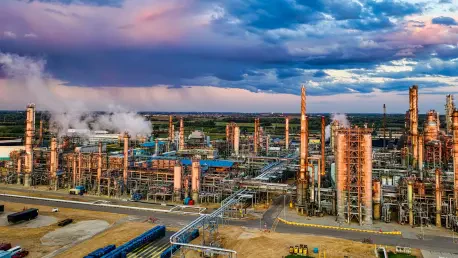The U.S. oil industry is experiencing a remarkable resurgence, with production levels climbing to near-record heights that rival the sector’s most prolific periods. Recent data from the Energy Information Administration reveals that weekly crude oil output has surpassed 13.5 million barrels per day, a threshold not crossed in several months and a figure that places current production among the highest in history. This surge signals a robust recovery for an industry that has faced volatility in recent years, driven by fluctuating global demand and domestic policy shifts. As key states navigate diverse challenges and opportunities, from drilling slowdowns to efficiency gains, the broader landscape of American oil production offers a complex but promising picture. This resurgence raises questions about sustainability, market dynamics, and the strategic moves shaping the future of energy in the nation.
Production and Market Trends
Surging Output Nears All-Time Peaks
The latest figures highlight a significant milestone for U.S. crude oil production, with a weekly average of 13,501,000 barrels per day marking a high not seen since early this year. This output falls just short of the historic peak of 13.6 million barrels per day recorded previously, underscoring the industry’s capacity to rebound amid economic and geopolitical pressures. The data suggests that technological advancements and operational efficiencies are bolstering production, even as the number of active drilling rigs declines in some regions. This near-record pace reflects a determined push by domestic producers to capitalize on favorable market conditions, despite lingering uncertainties around global oil prices. Moreover, the ability to sustain such levels indicates a maturing infrastructure capable of meeting heightened demand, both at home and abroad, while navigating the complexities of energy policy and environmental considerations.
Export and Import Fluctuations
Alongside soaring production, the U.S. oil market is witnessing notable shifts in export and import dynamics that reflect broader trade patterns. Exports recently dipped from a 21-month high of over 5.2 million barrels per day to under 4.5 million, though the four-week average still shows a rise of 200,000 barrels compared to last year’s figures. Meanwhile, imports surged by 14% week-over-week to approximately 6.5 million barrels per day, maintaining a relatively stable level compared to the prior year. These fluctuations point to a delicate balancing act as the nation adjusts to international demand and supply chain disruptions. The interplay between exports and imports also underscores the strategic importance of maintaining competitive positioning in global markets, where U.S. crude remains a critical player despite varying external pressures and domestic consumption needs.
Regional Dynamics and Strategic Reserves
Drilling Activity: A Mixed Regional Picture
Drilling activity across the U.S. presents a varied landscape, with some states facing declines while others demonstrate remarkable efficiency. In Kansas, the industry is grappling with a slowdown, as evidenced by only five new drilling permits issued and nine wells completed in a recent week, contributing to a year-to-date total of 850 wells—significantly lower than the over 1,000 recorded previously. The state’s rig count has also plummeted by 25% week-over-week to just 12 active rigs, half of last year’s tally. This downturn reflects broader challenges, including market hesitancy and reduced investment in traditional drilling operations. Such trends raise concerns about the long-term viability of oil activity in regions less equipped to adapt to shifting economic realities, highlighting the need for strategic interventions to stabilize local industry prospects.
Efficiency Gains in Key Shale States
In contrast to Kansas, states like Texas and New Mexico are showcasing impressive gains in productivity despite reduced rig counts. Texas saw a week-over-week increase of four rigs but remains down by 31 annually, while New Mexico added one rig but is down nine compared to last year. Despite these declines, both states have reported significant boosts in oil output, suggesting that advancements in drilling technology and operational efficiencies are yielding higher returns per rig. This trend points to a broader shift in the industry toward maximizing output with fewer resources, a critical adaptation in an era of fluctuating investment and regulatory scrutiny. The success in these shale-heavy regions also underscores the potential for other states to adopt similar strategies, potentially reshaping the national oil production framework over the coming years.
North Dakota’s Record Production and Environmental Progress
North Dakota stands as a beacon of progress, achieving a record-high number of producing oil wells at 19,547 in a recent month, up by 38 from the prior period. This increase has driven production to 1.16 million barrels per day, marking a slight uptick and reinforcing the state’s pivotal role in national output. Additionally, efforts to improve environmental outcomes are bearing fruit, with the natural gas capture rate reaching 95.2%, reducing flared gas by 15%. Such advancements highlight a growing commitment to balancing production growth with sustainable practices, setting a precedent for other oil-producing regions. The dual focus on output and environmental management in North Dakota offers valuable lessons for the industry as it navigates public and regulatory expectations.
Inventory Management and Strategic Reserves
Inventory levels and strategic reserves are also critical components of the current oil landscape, reflecting deliberate efforts to ensure stability. Commercial crude stockpiles recently decreased by over half a million barrels to just under 415 million, sitting 4% below the five-year seasonal average. Meanwhile, the Strategic Petroleum Reserve grew by 200,000 barrels to 406 million, a substantial rise of 24 million barrels compared to last year. This buildup, ongoing since early last year, signals a proactive approach to safeguarding national energy security amid fluctuating production and export levels. The careful management of these reserves demonstrates a recognition of potential market vulnerabilities, ensuring a buffer against unforeseen disruptions while supporting the industry’s capacity to respond to both domestic and global energy demands.
Reflecting on Industry Resilience
Looking back, the U.S. oil sector has demonstrated remarkable resilience as it navigated a complex array of challenges and opportunities. Production levels that neared historic highs underscored the industry’s ability to adapt, while regional disparities in drilling activity revealed the uneven nature of this recovery. Strategic moves to bolster the Strategic Petroleum Reserve provided a critical safety net, addressing vulnerabilities in a volatile market. Moving forward, stakeholders should prioritize investments in technology to sustain efficiency gains seen in states like Texas and New Mexico, while supporting struggling regions like Kansas through targeted policies. Additionally, adopting North Dakota’s dual focus on output and environmental stewardship could pave the way for a more sustainable future. These steps, grounded in the lessons of recent achievements, offer a roadmap for ensuring the long-term stability and growth of the domestic oil industry amidst evolving global dynamics.









